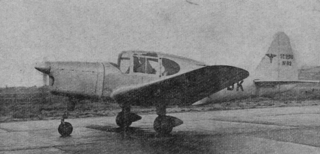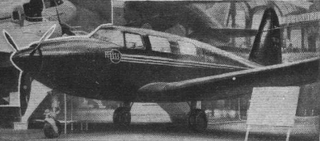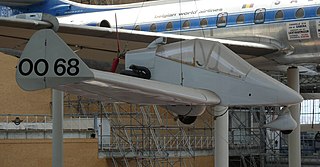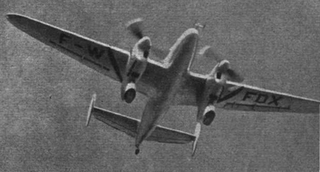
The Chasle YC-12 Tourbillon ("Whirlwind") was a single-seat light sporting aircraft developed in France in the mid-1960s and marketed for homebuilding via plans. It was a low-wing cantilever monoplane of conventional configuration. As designed, it featured fixed tailwheel undercarriage, but it could also be fitted with fixed tricycle gear.

The Nord 1601 was a French aerodynamic research aircraft designed and built by Nord Aviation. The aircraft was designed to investigate the aerodynamics of swept wings and related high-lift devices.
The Civil Aviation Department MG-1 was a one-off Indian motor glider, seating two side by side and first flown in 1983.
The Nicollier HN 500 Bengali is a single engine French light aircraft built in France in the 1980s. It seats two in side-by-side configuration. Only one was built, flying for the first time in 1988; it remains active with a French preservation group.

The Sud-Est SE-2300 or S.N.C.A.S.E. SE-2300 was a two/three seat low wing, single engine touring aircraft, built just after World War II in France. The SE-2310 was a tricycle undercarriage variant. Neither type went into production.
The Coupé-Aviation JC-01 is the first of a series of very similar designs of two seat, single engine sports aircraft, amateur built from plans in France from 1976. These provided a range of engine sizes and undercarriage layouts, but total production was small.
The Chasle LMC-1 Sprintair is an all-metal, single-seat sports light aircraft designed in France in the early 1970s and intended to be built by aero clubs from plans.
The Landray GL.01 is a small tandem-wing, side-by-side seat sport aircraft of the Mignet Pou-du-Ciel type. Built in the mid 1970s, the single example remains active.
The Barbaro RB-50 was a small, French, high wing single engine light aircraft, amateur built in the 1960s. Only one was completed.

The Payen Arbalète was a small, pusher configuration, experimental French tailless aircraft first flown in 1965.
The Payen Pa.47 Plein Air was a French two seat, high wing single engine tourer, which first flew in 1949. Only one was built.

The SNCASO SO.7010 Pégase was a six-passenger light transport aircraft developed in France immediately after World War II. It was powered by a pair of tandem-coupled V-8 engines but this power plant proved to be too troublesome for development to proceed.
The SNCASO SO.3050 was designed and built in France towards the end of World War II. Only one was completed and that was soon abandoned.

The SNCAC NC.1070 was a piston engined attack and torpedo bomber designed and built in France shortly after World War II. The second prototype, the NC1071, was the first French multi-jet turbine powered aircraft.
The Piel CP-40 Donald is a French homebuilt, single engine, single seat, high wing aircraft. It was first flown in the early 1950s, though the last of the three examples completed did not fly until almost forty years later.

The Hirsch or Hirsch-MAéRC H.100 is an experimental aircraft, built in France in the 1950s to test an aerodynamic gust suppression system. The system worked but was not further developed.

The French tailless Pottier P.40 was the first aircraft designed by Jean Pottier. It flew in 1975.
The Pottier P.60 Minacro is a homebuilt French single seat biplane designed for aerobatics. It first flew in the early 1990s; about six have been completed.

The Rey R.1 was an experimental twin engine aircraft type built in France around 1950 to test the effectiveness of sprung hinged wings in automatically correcting roll caused by gusts.
The S.E.C.A.T.-VI La Mouette or S.E.C.A.T. 60T La Mouette was a French two seat tourer built shortly before the outbreak of World War II.














